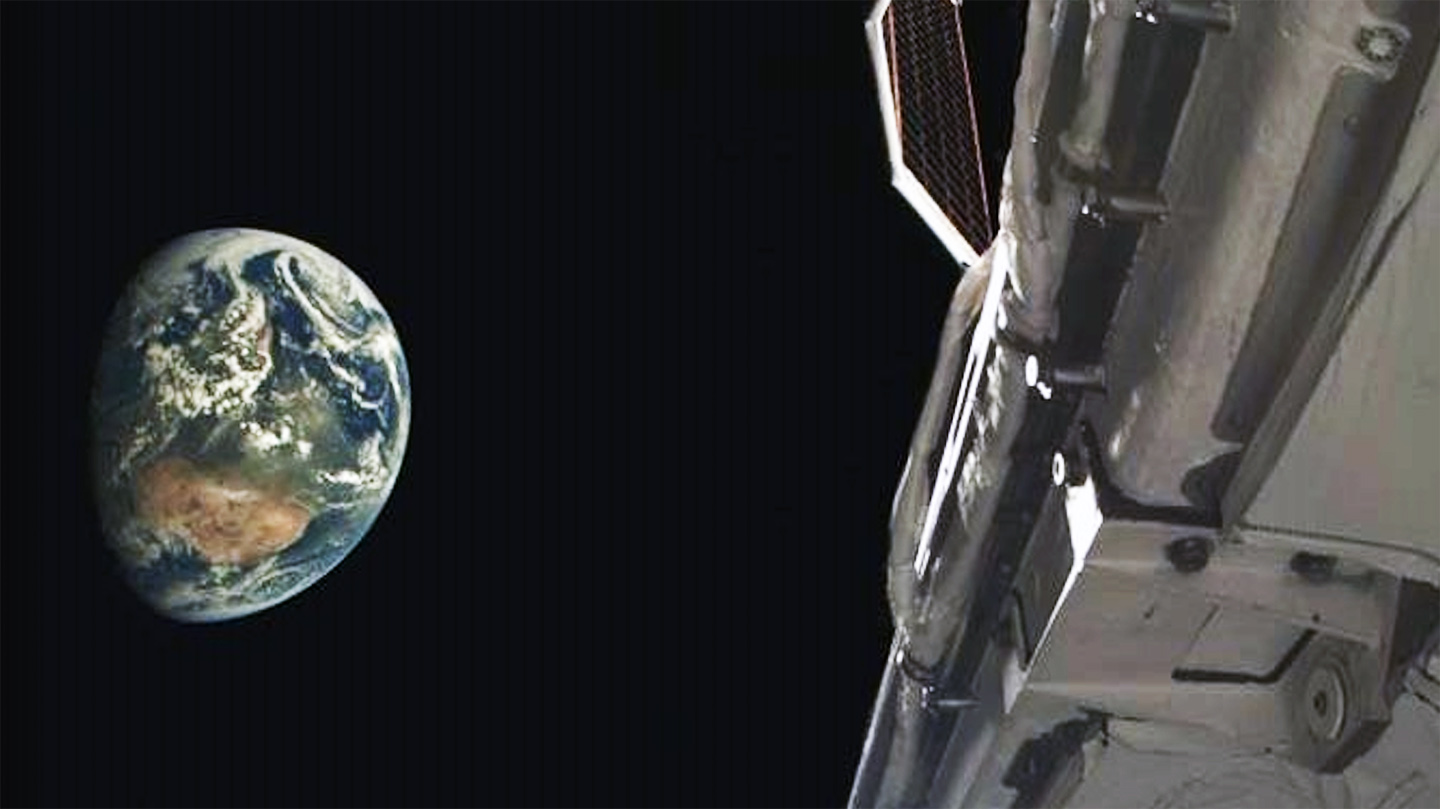For the first time, the U.S. Space Force has released a photo of Earth taken by one of its secretive X-37B mini-shuttles. The image appears to be the first in-orbit shot from the craft of any kind to be officially released by the Pentagon. However, a brief video clip published in 2023 did show the service-module-equipped X-37B separating from its launch rocket after being lofted into space in 2020.

The new photo, published by the Defense Visual Information Distribution Service (DVIDS) yesterday, shows Earth captured by an X-37B’s onboard camera, during its seventh mission, sometime last year. The image was taken “while conducting experiments in a highly elliptical orbit,” and the camera itself is primarily used to “ensure the health and safety of the vehicle,” the Space Force says. The caption notes that the X-37B’s seventh mission included, for the first time, a series of aerobraking maneuvers, used to change its orbit using minimal fuel.

The seventh X-37B mission, known as OTV-7, launched from the Kennedy Space Center in Florida on Dec. 28, 2023. The X-37B is still in orbit now, having passed 400 days in orbit on Jan. 31 this year. You can find out more about the mission in TWZ’s previous reporting.
In general, the Boeing-built X-37B has been incredibly camera-shy.
Before the photo published yesterday, and the video clip from 2023, the U.S. Space Force and Boeing only released the first pictures of the service module — including ones showing the U.S. Air Force Academy’s FalconSat-8, a small cubesat, and other payloads loaded onto it — after the conclusion of the OTV-6 mission in 2022.
A SpaceX video montage that includes a clip of the X-37B separating into space. The montage begins at approximately 3:38 in the runtime:
Boeing also previously released footage of an X-37B without the service module separating from its launch rocket during the OTV-1 mission, which began on April 22, 2010, and ended on Dec. 3 of that year.
This level of secrecy is hardly surprising given that the X-37Bs and their missions remain highly classified. This, in turn, has led to much speculation about their functions, including their potential use as space-based intelligence, reconnaissance, and surveillance (ISR) or weapons platforms. TWZ has discussed what is known about these spaceplanes and their capabilities in depth in the past.
As for OTV-7, some details about the mission have gradually emerged, adding to what we already knew about it when it began.
The launch, also known as USSF-52, used a Falcon Heavy rocket for the first time, meaning that the X-37B could be placed in a much higher orbit than on previous missions, as TWZ previously explored.
From the outset, Space Force had confirmed that OTV-7 would “include operating the reusable spaceplane in new orbital regimes,” implying that the mission would take the X-37B beyond the so-called geostationary orbit (GEO) belt around the Earth, as you can read more about here.
Orbits that take spacecraft beyond the GEO belt — which is defined as being around 22,236 miles (35,786 kilometers) above sea level — are categorized as high-Earth orbits (HEO).

Furthermore, OTV-7 involves taking the X-37B for the first time on a highly elliptical orbit (confusingly, also known as HEO).
In the past, former Air Force Secretary Heather Wilson referred to the X-37B’s ability to operate on a highly elliptical orbit, an egg-shaped trajectory that allows it to maneuver itself once it’s close enough to the atmosphere. The advantage of this is that it allows the spaceplane to reappear unexpectedly in orbit, making it harder for any potential adversaries to track.
A video shows a notional trajectory of the X-37B in a highly elliptical orbit:
“We know that that drives them nuts, and I’m really glad about that,” Wilson said, back in 2019.
A key aspect of the X-37B is that it is highly maneuverable and the spaceplanes have been observed changing their positions during previous missions.
The Space Force had previously said that OTV-7 would include “experimenting with future space domain awareness technologies, and investigating the radiation effects on materials provided by NASA.”
As far as payloads for OTV-7 are concerned, the Space Force has so far only revealed that the X-37B is carrying NASA’s Seeds-2 experiment, which will explore what happens to plant seeds exposed to “the harsh radiation environment of long-duration spaceflight.”
We now know a little more about some of the various aspects of the mission, including that Boeing developed a new collision avoidance system ahead of OTV-7. For the current mission, Space Force has identified about “1.7 million collision avoidance opportunities,” Chief of Space Operations Gen. Chance Saltzman told Aviation Week in a recent interview, referring to the threat posed by the proliferation of manmade objects in space.

The aforementioned aerobraking maneuver is another key aspect of OTV-7. According to Aviation Week, the X-37B vehicle needed some modifications, covering “fault protection, autonomy, and collision avoidance” to make it capable of this maneuver. This involves the spaceplane using the drag of the atmosphere to dip into low-Earth orbit (LEO), during which it can separate from its service module. You can read more about the aerobraking maneuver in the context of the X-37B in this previous story.

Saltzman told the same publication that the aerobraking maneuver was also used to evaluate the Space Force’s Space Surveillance Network, a collection of optical and radar sensors used to detect, track, identify, and catalog all human-made objects in orbit.
Finally, OTV-7 has been exploring autonomy, seen as vital as space becomes increasingly busy, especially since spaceplanes like the X-37B operate in various regimes.
Saltzman also said in the interview that there were no plans to use the X-37B as an operational vehicle, but it’s clearly being used to gather data that will inform both potential future U.S. spaceplanes and also gain a better understanding of how adversaries could use similar systems. Most notably, China has been busy testing a spaceplane, named Shenlong (meaning Divine Dragon), which is understood to be broadly comparable to the X-37B.

Some other details about the X-37B were recently provided to Aviation Week by Boeing’s Michelle Parker, company vice president for space mission systems. She confirmed that the company has been conducting continual upgrades on the X-37B, including introducing new types of batteries and solar cells.
“Even though it may look the same, a lot of the innards have been upgraded and then can continue to fly for a significant amount of time,” Parker told the magazine.
While we are still being drip-fed new information about the X-37B, the fact that more is being disclosed may well reflect calls from U.S. officials and members of Congress to reveal more regarding military activity in and related to space.

With the X-37Bs now assigned to the Space Force’s main unit tasked with “orbital warfare,” their military role is now made explicit. Meanwhile, more efforts have also been made to try and communicate to the public about the importance of space to military operations (and daily life) and potential threats outside of the Earth’s atmosphere, as well as what the U.S. government is doing about those issues.
Bearing in mind the activities of near-peer adversaries like China or Russia, space is now indisputably a key military domain and potential battlefield in future conflicts. In particular, the ability of China and Russia to threaten U.S. and allied activities in space via various anti-satellite weapons is a growing area of concern.
Currently, it’s unclear to what degree the new Trump administration might change how sensitive U.S. military space missions might be communicated to the public. However, the release of a photo showing — for the first time — the Earth seen from an X-37B is certainly a welcome glimpse into the still-secretive world of these hard-working spaceplanes.
Contact the author: thomas@thewarzone.com





